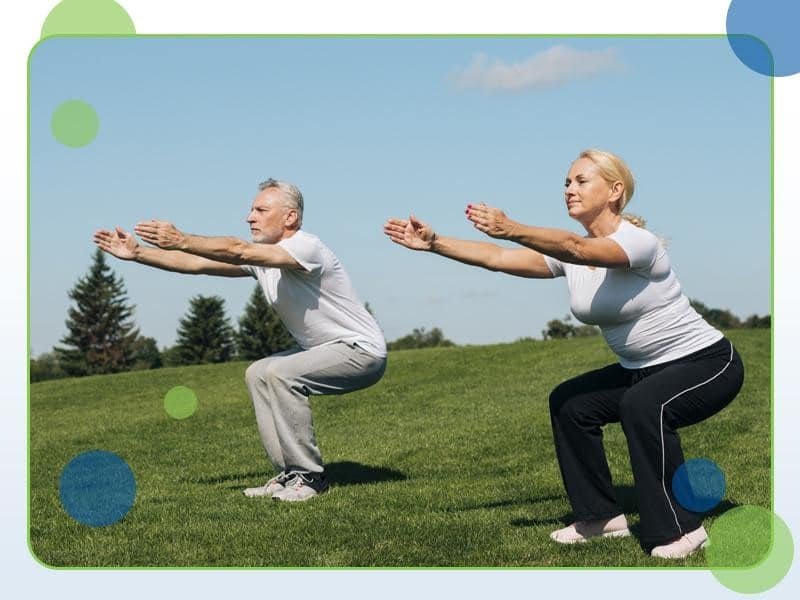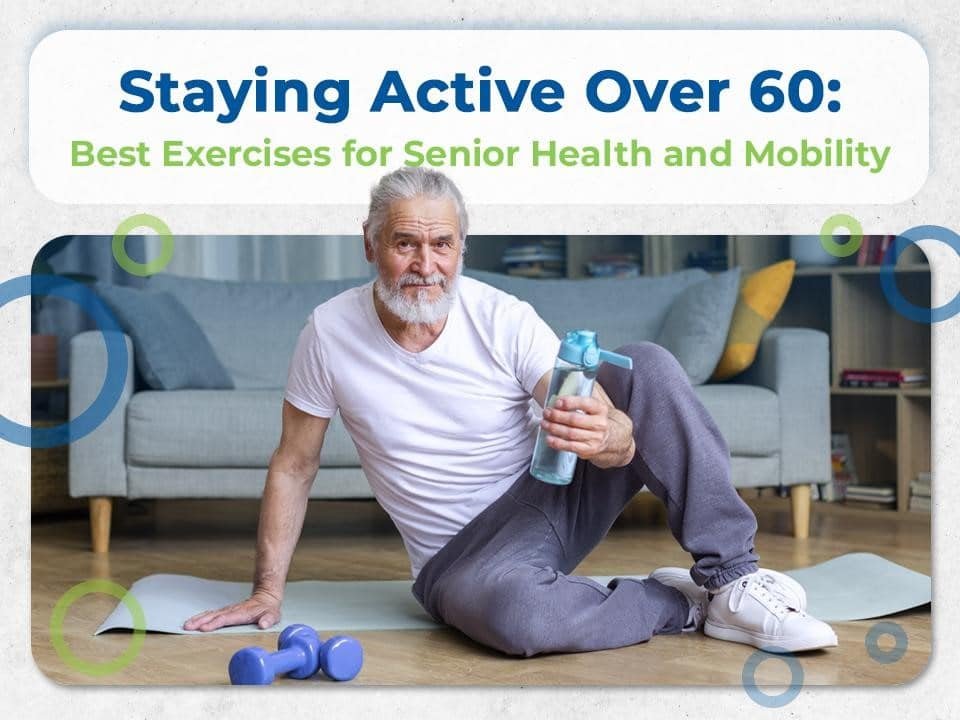Staying physically active is a cornerstone of health at any stage of life, but its significance grows as we age. For seniors, regular exercise isn’t just about maintaining fitness; it’s a vital component of sustaining independence, preventing the onset of chronic health issues such as heart disease and diabetes, enhancing mental health, and ensuring mobility remains robust. As we age, our bodies change, and what worked for us in our thirties or forties may not be suitable as we enter our sixties and beyond. Therefore, adapting our exercise routines to align with our current physical capabilities and health needs is crucial.
This guide is designed to help seniors over 60 navigate the landscape of physical activity, offering a curated list of exercises that prioritize safety, effectiveness, and, importantly, enjoyment. These exercises are chosen to accommodate the unique needs of older adults, focusing on gentle yet effective activities that minimize risk while maximizing health benefits. Whether you are active or looking to get started, this guide provides valuable insights into maintaining a healthy and active lifestyle during your senior years, ensuring that each exercise contributes to physical health and overall quality of life.
Understanding the Importance of Exercise for Seniors
Exercise is more than just a routine for seniors; it’s fundamental to maintaining and enhancing overall health and well-being as we age. Regular physical activity is critical for the body and mental and emotional health, offering a range of benefits that are particularly important for older adults.
1. Enhance Cardiovascular Health
- Heart Health: Regular exercise helps keep the heart muscle strong, promotes good circulation, and can help regulate blood pressure and cholesterol levels, critical factors in cardiovascular health.
- Disease Prevention: Exercise can significantly lower the risk of cardiovascular diseases, a leading cause of morbidity and mortality in seniors, by improving heart function and circulation.
2. Increase Strength and Stability

- Fall Prevention: Improving muscle strength and balance through exercise is one of the most effective ways to reduce the risk of falls, which are common concerns among older adults and can lead to severe injuries.
- Muscle Maintenance: Regular physical activity helps combat the loss of muscle mass and bone density with age, supporting physical stability and independence.
3. Boost Mental Health
- Cognitive Function: Exercise has been shown to improve cognitive function, helping to delay the onset of dementia and cognitive decline, which are concerns for many seniors.
- Emotional Well-being: Regular physical activity can also significantly help manage and reduce symptoms of depression and anxiety, contributing to better overall mental health and quality of life.
4. Enhance Flexibility and Mobility
- Joint Health: Exercises that enhance flexibility help maintain joint health, reducing stiffness and pain associated with arthritis.
- Daily Activities: Improved mobility makes it easier for seniors to perform daily activities, promoting greater independence and enhancing quality of life.
5. Promote Social Engagement
- Community Connection: Participating in group exercises, whether at a gym, community centre, or even a walking group, provides valuable opportunities for social interaction, vital for emotional health and can combat feelings of loneliness and isolation.
- Support Networks: Regularly engaging in social activities through exercise can help build strong support networks, which are crucial for mental well-being and resilience in older age.
By understanding and embracing the multifaceted benefits of regular exercise, seniors can significantly enhance their cardiovascular health, strength, mental acuity, flexibility, and social connections. Each element plays a critical role in surviving and thriving in later life, making exercise an essential component of a holistic approach to healthy aging.
Ideal Exercises for Seniors
Engaging in physical activity is crucial for maintaining health as we age. The key is choosing safe, enjoyable, practical exercises to maintain or improve overall fitness and health. Here are some carefully selected exercises that are particularly well-suited for seniors:
1. Walking
- Benefits: Walking is a fantastic cardiovascular exercise that maintains heart health and enhances muscular endurance. It’s low-impact, easy on the joints, and great for long-term mobility.
- Tips: To keep walking engaging, vary your routes to include different parks, nature trails, or city paths. Incorporate intervals of increased pace or gentle slopes to enhance cardiovascular benefits without overly straining. Always wear comfortable, supportive footwear to protect your joints.
2. Water Aerobics
- Benefits: Water aerobics is excellent for seniors. The buoyancy of water reduces strain on joints and muscles while providing resistance that helps build strength and stamina.
- Tips: Look for water aerobics classes that cater to different fitness levels. Engaging with instructors who specialize in senior fitness can provide a safer, more tailored workout experience. Also, consider sessions that use pool noodles or flotation devices for variety and added fun.
3. Tai Chi

- Benefits: Tai Chi is often called “meditation in motion” and offers a unique blend of gentle movements and stress reduction. It can significantly improve balance and coordination, reducing the risk of falls.
- Tips: Join beginner classes and focus on mastering the form of each movement rather than speed or perfection. Practice regularly to see gradual improvements in your flexibility and mental clarity.
4. Strength Training
- Benefits: Strength training is crucial to combat the natural loss of muscle mass with age. It supports bone health, improves metabolism, and can help manage weight.
- Tips: Utilize resistance bands or light dumbbells to perform strength-training exercises. Incorporate full-body workouts twice a week, allowing rest days in between. Exercises like squats to a chair, wall push-ups, and light dumbbell lifts are effective and safe.
5. Yoga
- Benefits: Yoga enhances flexibility, strengthens muscles, and improves balance. It also offers significant mental health benefits, aiding relaxation and stress management.
- Tips: Attend classes that offer “Yoga for Seniors” or “Chair Yoga” to start with modifications that accommodate mobility limitations or balance concerns. Use props like yoga blocks and straps to aid in achieving poses.
6. Cycling
- Benefits: Cycling, especially on a stationary bike, can increase leg strength and improve cardiovascular health without stressing the joints.
- Tips: Ensure the bike is adjusted to your height to avoid knee strain. Start with short sessions at a comfortable resistance and gradually increase both duration and intensity. Consider group cycling classes to stay motivated.
Read More: Medicare Coverage for Orthopedic Health: A Comprehensive Overview
Guidelines for Safe Exercise
Exercising safely is crucial, especially for seniors with unique health considerations. Adhering to the following guidelines can help minimize the risk of injury and maximize the benefits of staying active:
1. Consult Your Doctor
- Personal Health Assessment: Before embarking on any new exercise regimen, it is imperative to consult with your healthcare provider. This step is crucial for those with pre-existing health conditions such as heart disease, high blood pressure, joint problems, or diabetes.
- Tailored Exercise Plan: A healthcare provider can help develop an exercise plan that suits your specific health needs, considering any limitations or risks. They can offer guidance on the types and amounts of exercise that are safe and beneficial for you.
2. Warm-Up and Cool Down
- Importance of Warming Up: Begin each exercise session with a warm-up to prepare your body for physical activity. A good warm-up gently revs up your cardiovascular system by raising your body temperature and increasing blood flow to your muscles. Warm-up exercises include strolling, marching in place, or performing dynamic stretches.
- Cooling Down: Ending your session with a cool-down helps gradually bring your heart rate and blood pressure back to normal levels. Gentle stretching can help relax your muscles and prevent stiffness, aiding recovery and reducing the risk of injuries.
3. Stay Hydrated
- Adequate Fluid Intake: Proper hydration is essential for safe exercise. Seniors are particularly prone to dehydration, which can affect their strength, energy, and coordination and even lead to serious health issues.
- Hydration Tips: Drink water before, during, and after your workout, even if you don’t feel thirsty. Keeping a water bottle within easy reach during exercise can remind you to take regular sips.
4. Listen to Your Body
- Understanding Limits: Pay close attention to how your body feels during exercise. While it’s normal to feel some exertion, you should not experience pain. Exercise should be challenging but not overwhelming.
- Signs to Stop: Immediate signs that you should stop exercising include pain, dizziness, lightheadedness, or severe shortness of breath. These could be signs of overexertion or other severe conditions that require medical attention.
Additional Safety Tips
- Wear Appropriate Gear: Use proper footwear and comfortable, breathable clothing appropriate for the type of exercise you are doing. Proper shoes can help prevent falls and other injuries.
- Use Support When Needed: Don’t hesitate to use a chair or a wall for balance exercises. Safety always comes first.
- Regular Reviews: Periodically review your exercise plan with your healthcare provider to adjust for any new health issues or to increase the intensity of your workouts as your fitness improves.
By following these guidelines, seniors can enjoy the immense benefits of physical activity safely and effectively. Remember, the goal of exercise in your senior years is to enhance physical health and improve overall quality of life and independence.
Staying Motivated
Maintaining a regular exercise routine can sometimes feel challenging, but with the right strategies, you can stay motivated and enjoy the many benefits of physical activity. Here are some additional tips to help seniors stay engaged and committed to their exercise plans:
1. Set Realistic Goals
- Manageable Objectives: Begin with small, achievable goals that make you feel accomplished without becoming overwhelmed. For example, aim to walk for 15 minutes daily and gradually increase your time as you become more comfortable.
- Celebrate Milestones: Each time you reach a goal, take the time to celebrate your achievement. This recognition can be a powerful motivator for continuing to progress.
2. Exercise with Friends
- Social Benefits: Exercising with friends or in a group makes the activity more enjoyable and builds a support network that can keep you accountable. Social interactions during exercise can improve your mood and encourage regular participation.
- Group Classes: Consider joining exercise classes geared towards seniors, such as yoga, water aerobics, or dance classes. These can offer a sense of community and make physical activity a social event rather than a solitary duty.
3. Track Your Progress
- Activity Logs: Keep a detailed log of your exercises, including what you did and how long you spent on each activity. This record can help you see your improvements over time and adjust your goals accordingly.
- Tech Tools: Use fitness trackers or apps to monitor your progress and gain insights into your health metrics, such as heart rate, steps taken, or calories burned. These tools can add an element of fun and competition to your routine.
Conclusion
Staying active is essential for seniors to extend life and enrich their quality of life. You can enjoy a healthier, more active lifestyle beyond 60 with the right exercises tailored to your needs and capabilities. Consistency and finding joy in your chosen activities are the keys to a successful exercise regimen. Incorporating regular physical activity into your daily routine can significantly boost your health, enhance mobility, and improve your overall quality of life. Staying active as a senior is about more than just physical health; it’s about maintaining independence, nurturing social connections, and enjoying the years that retirement brings. With commitment and the right approach, every senior can achieve a vibrant, active lifestyle that contributes to longevity and quality of life.







